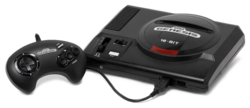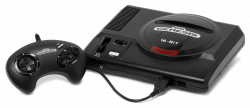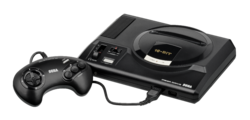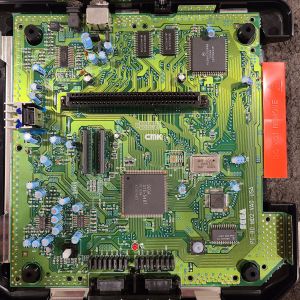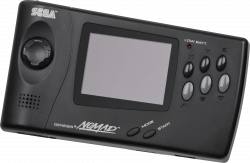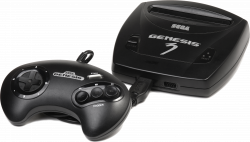Genesis:Motherboard Differences
Some page content & researching taken from io55.net's Sega Genesis page with permission, in collaboration.
There were numerous models and variations of the Genesis/Mega Drive hardware produced over the years, ranging from standalone consoles to handhelds and even an unusual boombox/game console hybrid. This page serves to document these models and all variations (if any) found within each.
Models and Revisions
Models are arranged chronologically. Revisions are underneath their respective model.
Model 1 (1988-1993)
The model 1 Genesis/Mega Drive is easily distinguished from the model 2, as it is rectangular, with a large and raised circular area on top containing the cartridge slot, "16-Bit" text and the console logo in the case of the Genesis. Audio output is known as being vastly superior on most of these models, although stereo must be routed through the headphone jack instead of the usual AV port, which was inherited from the Master System. One downside is that most revisions have a minor "vertical bar" issue in the video output, while revisions with lessened vertical bars come with the TMSS (TradeMark Security System) lockout program. Earlier revisions of the Model 1 have an EXT port on the back, similar in pin structure to a 9-pin RS-232 serial port. One specific late revision of this model has horrible audio quality. Production largely stayed in Japan though most Western models were manufactured in Taiwan, China and Thailand.
837-6656 - "VA0" (1988, Japan)
This is the earliest revision of the model 1 and is only found in Japanese Mega Drive consoles. These are distinguished by a small daughterboard which contains the master oscillator crystal and a few support chips. During manufacturing, Sega discovered a flaw with the EDCLK signal on the motherboard as designed, and this daughterboard generates a correct EDCLK signal which is fed back into the VDP. Although the board is not designated as such, it is commonly referred to as the "VA0" in keeping with Sega's revision naming practices and the fact that it was the first board revision produced.
The VA0 revision also has a significant flaw with its stereo audio output. While the balance between frequencies is excellent, the preamp is far too high, resulting in horrible distortion in games that are too loud. However, this can be fixed by substituting several capacitor and resistor values on the underside of the motherboard.
One interesting curiosity is that the cap for the headphone volume slider can be easily removed by simply pulling it up. This would be secured by tack welds on later consoles.
Consoles with a VA0 board have a serial number beginning with either "88M" or "98M" and all were produced in Japan.
VA1 (1989, Japan)
Introduced very early in 1989, the VA1 incorporates the EDCLK daughterboard into the motherboard by adding an additional chip, the 315-5339. Like the "VA0" before it, this board is only found in Japanese Mega Drives and also has the same issue with the overdriven preamp.
Consoles with a VA1 board have a serial number beginning with either "89N" or "99N" and all were produced in Japan.
VA2 (1989, Japan and North America)
This is the first board revision for the Genesis and is also found in Japanese Mega Drive consoles. On this revision, the 315-5339 EDCLK generator chip was replaced with the 315-5345, which added an additional bus acknowledgment signal (/BGACK) going to the VDP. It uses this signal to prevent potential glitches related to the VDP's DMA (direct memory access) refresh timing.[1] No other changes were made and the overdriven preamp issue was also carried over.
Japanese consoles with a VA2 board have a serial number beginning with either "39M", "89N" or "99N". "39M" consoles were produced in Taiwan with the other two being produced in Japan. All US VA2 consoles were produced in Taiwan and can have a serial number beginning in "39S" through "39X", or "30T" through "30W".
VA3/VA4 (1989-1991, All Regions)
The audio situation has been changed from previous board revisions, lowering the preamp, but somewhat altering the balance between frequencies. This results in no more distortion in loud games, but a slightly poorer frequency response curve, leading to a minor muffling. The 315-5308 and 315-5345 bus arbiter and EDCLK chips in previous board revisions were also consolidated into a single IC in the VA3, known as the 315-5364. VA3 boards are only found in US Genesis and Brazilian Mega Drive consoles, while the near identical VA4 board is only found in Japanese and PAL Mega Drive consoles (being the first board revision for the latter), as well as the Korean Samsung Super Gam-Boy.
PAL Mega Drive consoles with a VA4 board can be distinguished by the presence of the EXT port at the rear and the silkscreened text "High Definition Graphics - Stereo Sound" above the cartridge port.
US consoles with a VA3 board were largely produced in Taiwan with some being manufactured in China or Japan. All Japanese VA4 consoles were produced in Japan with all PAL VA4s being manufactured in China.
VA5/VA6 (1990-1992, Japan, North America, Brazil and Asia)
Introduced in late 1990, this board design saw further consolidation by combining the 315-5308 and 315-5364 into a single I/O chip. Composite video output was moderately improved with the reduction of the "rainbow" banding common on earlier revisions, and the excellent audio quality of the VA3 and VA4 boards was carried over. Both VA5 and VA6 boards are completely identical, but each one has a different I/O chip.
VA5 boards use the 315-5402 I/O chip which does not have TMSS, and are only found in Asian and Japanese Mega Drive models. The VA6 revision uses the 315-5433 chip, which adds the “TMSS” lockout screen (Produced by or under license etc.) that appears for several seconds before playing any game. This was added in order to deter unlicensed games and initially only appeared in US Genesis consoles. These are mostly identifiable by the FCC ID, which has been shortened to “FJ8USASEGA”, but the most notable indicator is a silver or white strip listing several patent numbers below the FCC ID. VA6 boards were first introduced in US consoles during 1991, around the same time Sega replaced Altered Beast as the pack-in with Sonic the Hedgehog, and made their way to Asian and Japanese Mega Drives later that year. The VA6 revision was also used in the Brazilian Mega Drive II. Asian and Japanese VA6 systems can be identified by the addition of a bottom label listing several patent numbers, the same ones listed on North America VA6s.
Most US VA6 consoles were produced in Japan and Taiwan. All Japanese and Asian VA5 and VA6 consoles were produced in Japan.
For the remaining model 1 revisions, the "High Definition Graphics" slogan at the top is removed. The "AV Intelligent Terminal" text on Asian/Japanese models was also removed at around the same time.
VA6.5 (1992-1993, North America and PAL)
These are easily identified by the aforementioned slogan removal, alongside viewing the ports at the back. The EXT port is no longer available on these consoles, but the other ports have not changed position compared to prior revisions. This presentation will result in the four remaining ports being justified to the right of the I/O area, leaving a reasonable gap to the left where the EXT port was. Outside of this change, this revision is identical to other VA6 boards, including the good audio quality. The "VA6.5" revision name is found in Sega service documentation but not the actual motherboard, since it is simply a VA6 with the EXT port and its supporting circuitry unpopulated.
It is worth noting that the EXT port was not removed for Japanese models as the Mega Modem attachment, which made use of this port, was still being actively supported. As a result, VA6.5 boards are only found in US Genesis and PAL Mega Drive consoles; most model 1 PAL Mega Drive consoles are of this revision.
On most VA6.5s, the colored part of the bezel surrounding the power LED is actually a separate piece of plastic, and the "ring" around the cartridge port area is molded as part of the top shell and is no longer a separate trim piece like on earlier consoles. These changes were also carried over to the later VA7 revision.
Most US VA6.5 consoles were manufactured in Japan or Taiwan with some being produced in China. The vast majority of PAL VA6.5 systems were produced in China with some coming from Japan, Malaysia and Thailand.
VA6.8 (1992, PAL)
Only found in European Mega Drives, the VA6.8 revision is largely identical to the VA6 but has a surface-mount Fujitsu MB3514 video encoder in place of the DIP Sony CXA1145 found in all other models.
VA7 (1992-1993, Japan and North America)
Introduced in late 1992, the VA7 was the final and most drastic revision of the model 1 released. It is the first standalone Genesis/Mega Drive to use the FC1004 ASIC found in most model 2 consoles, which combines the VDP, I/O and a YM3438 audio chip into a single chip. All VA7s use a surface-mount version of the Sony CXA1145 encoder as well as a QFP version of the Motorola 68000 CPU.
The ports on the back have been shifted significantly to the left, having the AV out occupy where the EXT port used to be (except on Japanese VA7s which still have the EXT port present), which leaves a large gap to the right. In addition, the sound output is notoriously bad when compared to other revisions; it is muffled, filled with hiss, and possesses a flat frequency range with excessive distortion. This is due to Sega using an inadequate amplifier circuit and can be corrected using a modification board such as the Triple Bypass or Mega Amp. Despite this, composite video quality is slightly better than on previous revisions. This revision is only found in US Genesis and Japanese Mega Drive systems.
All US VA7s were produced in either Japan or Taiwan while all Japanese VA7s were made in Japan.
TeraDrive (1991)
Introduced in May 1991 as a collaboration between IBM and Sega, the TeraDrive is a combination of a Mega Drive and an IBM PC. The system is a slim desktop PC with the Mega Drive cartridge slot, 3.5" floppy drive(s), headphone jack with volume control, Mega Drive controller ports and two PS/2 ports at the front panel. At the rear are a 9-pin RS232 serial port, DB25 parallel port, RGB out, composite video out with stereo audio, a Mega Drive EXT port and space for a single ISA expansion card. The TeraDrive was available in three configurations; the Model 1 featured 640 KB of RAM and a single floppy drive, the Model 2 with 1 MB RAM and two floppy drives, and the Model 3 with 2.5 MB RAM along with a single floppy drive and a 30 MB hard drive. Because of the TeraDrive's large form factor and lack of a Mega Drive expansion port, it is not compatible with a Mega CD unit.
However, both the Mega Drive and PC-compatibles were not popular in Japan during this time, not helped by the fact that the TeraDrive had a fairly weak 286 CPU while most PCs had moved on to 386 or 486 processors. As a result, the TeraDrive sold very poorly and it has since become a very rare collector's item.
Wondermega (1992)
Perhaps the most exorbitant of all Mega Drive consoles, the Wondermega is the first console to combine both a Mega Drive and a Mega CD in a single unit. A Japan-only release, the Wondermega was released in April 1992 under both the Sega and Victor (JVC) brands, with the Victor model coming first by a few weeks. In addition to playing both Mega Drive and Mega CD games, the Wondermega is loaded with features such as S-video out, MIDI out, two microphone inputs for karaoke, and a DSP for audio effects. To add to the opulence, the top-loading disc door is motorized and can automatically open or close through the controller. Two green light strips are also on each side of the disc area.
Both the Sega and Victor models are identical with only very minor cosmetic differences, mainly limited to the colors of the power and reset buttons and the trim piece on the disc door. The Sega model also retailed for a slightly lower price (79,800 yen vs. 82,800 yen) than the Victor model. Due to their very high prices, both Wondermega models sold in limited numbers and are now highly sought after.
Model 2 (1993-1998)
With the Genesis/Mega Drive's increasing popularity, particularly in Western markets, Sega introduced a completely redesigned console in early 1993 for all markets. These models introduced a smaller, square case with a more rounded design. The headphone jack has been removed, although the A/V output now supports stereo. For all models, the EXT port is completely removed, and audio output on some revisions is noticeably worse compared to the model 1. The RF port and channel switch have also been removed on most Western models, as all models now make use of an external RF modulator. In Brazil, TecToy released the model 2 as the "Mega Drive III", as the "Mega Drive II" name was previously used on a revision of the model 1.
All model 2 revisions can be distinguished by viewing the motherboard through the cartridge slot, and some by looking through the bottom vents. See the "Sega-16" guide linked below for details.
VA0/1/1.8 (1993-1996, All Regions)
These are for the most part, very similar to the VA7 model 1. The sound quality still suffers though is not as bad as the VA7, leaving only the incessant hissing. Alas, the lack of a volume slider (since the headphone jack was removed) eliminates any ability to change the volume of the hiss. At times, the video output may also be very poor if the console uses the Samsung KA2195D video encoder; this is something that can only be determined by opening the console.
The VA1 differs from the VA0 mainly in that it consolidates the two VRAM chips and two 68K RAM chips with one chip each - and there are major trace routing changes to accommodate this. However, there are also some resistor values changed in the audio circuit that likely reduce distortion in these later revisions: R42 through R45 are increased from 4.7 kohm to 7.5 kohm, while R81 is decreased from 7.5k to 6.8k.
It is unclear what exactly is different between the VA1 and VA1.8, as the boards appear mostly identical with the exact same components and no documentation of this difference has been found. Some VA1.8 boards have two wires between the positive and negative pins of the power jack and two solder pads on the underside which are not present on earlier boards.
All three of these mainboard revisions come with or without HAL (Hot-Air Solder Leveling), although the "HAL" text is not always present on the boards which have it. In addition, all three of these mainboard revisions also come with or without plated through-holes, and the layout is slightly different between these variations. The non-plated variations have extra vias. The non-plated variations also have jumper links in place of some power traces.
In Japan, the Mega Drive 2 only features either the VA0 or VA1 revision; later board revisions did not appear in Japan due to the Mega Drive's unpopularity there. For some unknown reason, Japanese and Asian Mega Drive 2 consoles use a slide switch for power like the model 1 instead of a push button switch, and lack a power LED.
Early Brazilian Mega Drive III consoles have a VA0 board but with a small RF modulator board crudely soldered onto the side of the board, with the RF output jack sticking out of the side of the console. In later versions, TecToy used a board revision of their own design, which was heavily based on the VA1/VA1.8. This revision integrated the RF out on the motherboard (with the output jack now at the rear) and featured an internal power supply with switchable input voltage.
VA2/2.3 (1994-1996, North America)
Sound-wise, these are noticeably better than the 7/0/1/1.8 revisions, but it is still not perfect. Hissing is removed, but volume balancing, PSG sound, Master System, CD, and 32X sound are all faulty in some way. However, the likelihood of getting the bad Samsung video encoder chip is higher, although some of these will have a Sony CXA1645 instead, which is bright, sharp, and vivid. These are also the only revisions of the model 2 which have a discrete YM2612 like most model 1s, as the ASIC used in these revisions does not have a YM3438 core.
This board revision is only found in US Genesis consoles.
For the following model 2 revisions, the motherboard’s size has been reduced by a quarter lengthwise. To determine the difference, look at the bottom of a model 2. If the metal shielding visible through the exhaust vents end a significant distance from the edge of the console, it is a ¾ motherboard. If the metal plates practically touch the edge of the console, it is a full size board.
VA3 (1994-1996)
Identifying these can be done by looking for square cutouts on the RF shielding visible through the bottom vents. If the shielding has no square cutouts, it is of this revision. Depending on the encoder chip, video quality of these can range from utterly poor to acceptable. If this revision has a Sony CXA1645 or a Samsung KA2195D, the video output will likely be mediocre to horrible (although the Samsung isn’t the worst of the two). Luckily, sound is universally improved on the VA3, resulting in audio quality close to the first model 1s (although with a minor difference in the PSG volume). These will have compatibility issues with the MK-84000 model of the 32X.
Like the VA2 and VA2.3 consoles, this board revision is only found in US Genesis consoles.
VA4 (1996-1998)
This was the final board revision for the model 2 and appears to be the best for both audio and video quality. All video issues have been eliminated, as the Sony CXA1645 chip in these is back to being crisp, colorful, and vivid. Furthermore, the sound has been improved a little more, with less DAC noise than on the VA3. To identify one of these, look for two square cutouts on the shielding visible through the bottom vents. These will also have compatibility issues with the MK-84000 model of the 32X.
The VA4 is especially notable in that it is the first Genesis console to use a GOAC (Genesis On A Chip) ASIC, which incorporated all of the major components of the console into a single chip, save for the RAM and video encoder. Due to this change, the VA4 also consumes far less power than any other model 2.
Later VA4s in North America were sold under license by Majesco in 1998, who marketed the Genesis as a budget console. The build quality is largely identical to the earlier Sega-built examples. This was also the final board revision for the PAL Mega Drive II. PAL VA4 boards also feature a ROHM BH7236AF encoder, which is pin-compatible with the CXA1645.
Amstrad Mega PC (1993)
Much like the TeraDrive before it, the Amstrad Mega PC is a combination between an IBM-compatible PC and a Mega Drive. It was only released in Europe and Australia during 1993 and also shipped with a dual 15/31 kHz monitor. Unlike the TeraDrive, the Mega PC featured a 386 processor and had the Mega Drive hardware on a separate ISA card (this was integrated in the TeraDrive's motherboard). Also unlike the TeraDrive, the Mega Drive portion could not interact in any way with the PC side, and a sliding door on the front covers the Mega Drive cartridge slot or 3.5" floppy drive depending on which section is used.
Although it saw somewhat greater success than the TeraDrive, the Mega PC still sold in fairly small quantities, possibly due to its high price and the fact that it used a 386 while most PCs were using 486 CPUs. Amstrad announced a revised model with a 486 called the "Mega PC Plus" to rectify this, but it was never released.
Wondermega M2/X'Eye (1993-1994)
In 1993, Victor/JVC introduced a completely redesigned Wondermega, known as the Wondermega M2 (model number RG-M2). This new Wondermega featured a smaller, sleeker case and came packaged with a wireless infrared 6-button controller which could also double as a basic TV remote. This controller could also turn on the console remotely and had a controller port for a second player, not unlike 3DO controllers. However, a number of cost-cutting changes were made, including the removal of the DSP audio effects, the motorized disc door and MIDI out. The Wondermega M2 could also still use wired controllers, although the controller ports were moved to the rear of the console to leave room for the infrared receiver at the front.
Much like its closest competitor, the PC Engine Duo, the Wondermega M2 also suffers from leaky surface-mount capacitors and any M2 unit should be fully recapped in order to keep it functioning.
During the spring of 1994, JVC brought over the Wondermega M2 to North America as the JVC X'Eye, which retailed for US$499.95 and came bundled with a variety of CD software, including Compton's Interactive Encyclopedia, Prize Fighter, and a karaoke CD. Further cost reductions were made with the X'Eye, with both the S-video output and infrared receiver being removed, as well as one of the microphone inputs and the volume control for the headphone out. The controller ports were relocated to the front of the console to compensate for the removed IR receiver, and the power button was also changed from the momentary type used in the M2 to a push button switch like in a model 2 Genesis. A JVC-branded version of the standard Genesis 3-button controller was also bundled with the console.
Most X'Eyes also feature the same 9-pin mini-DIN connector found in the model 2 Genesis, meaning that a 32X can be connected to these X'Eyes. However, the 32X blocks the disc door, so it must be removed every time the disc door is opened. For 32X owners, JVC offered a service where the console was given a modified disc door, allowing it to fully open with a connected 32X. This service was also made available to Wondermega M2 owners in Japan for a 5,000 yen fee until 2013.
Mega Jet (1993-1994)
Perhaps one of the most novel versions of the Genesis/Mega Drive hardware, the Mega Jet is a semi-portable console initially made available in 1993 on certain Japan Air Lines flights and on March 10, 1994 to the general public in Japan only. It is essentially a VA3 revision model 2 condensed into a handheld form with a built-in 6-button controller, although it lacks a built-in screen or the ability to accept batteries, basically making it akin to a "plug & play" controller with a cartridge slot. Curiously, the Mega Jet has a fully wired cartridge port, allowing it to support Master System games and passthrough audio from a flash cart such as a Mega Everdrive Pro or Mega SD. Although the 32X will fit into the cartridge port and can function on the Mega Jet, it does not leave enough room for the necessary video jumper cable to be connected.
The Mega Jet's hardware would later form the basis for the truly portable Genesis Nomad.
CDX/Multi-Mega (1994)
Released in 1994, the Sega Genesis CDX is a small console combining the Sega CD and Genesis/Mega Drive together, while also functioning as a portable CD player. Only some thousands of these were made, resulting in significant rarity. Video quality of these systems is quite good, but the sound is a bit mixed (too quiet, weak bass without headphones). FMV-heavy Sega CD games may freeze up on this system. It is compatible with the 32X and Power Base Converter despite its different physical form compared to standalone Genesis/Mega Drive consoles, and also features the same 9-pin mini-DIN video out as the model 2 with RGB output.
Unlike the JVC/Victor combination consoles, the CDX was also released in PAL regions, Asia and Brazil, where it was known as the Multi-Mega. Curiously, the CDX was not released in Japan by Sega themselves, but by the global language training company Linguaphone, who sold it as an educational tool and branded it as the Education Gear .
Aiwa Mega CD (1994)
One of the most unusual console variants ever released for any system, the Aiwa Mega CD (model number CSD-G1M) is a combination of a Mega Drive, Mega CD and boombox complete with CD player, cassette deck and radio tuner. Both the boombox and Mega Drive/Mega CD are separate components, presumably so that the boombox can be taken on the go to play music while the game hardware remains behind at home; the two are connected via a DB25 cable. The front of the "dock" has the cartridge port at the center with the two controller ports on each side of it. The rear features a DB25 connector for the docking cable and the same 9-pin mini-DIN found on the Mega Drive 2. Power is provided via the boombox's power supply. Although not designed for them, the CSD-G1M is compatible with the 32X and even Master System adapters, although care must be taken due to the cartridge port being mounted at the front.
The Aiwa Mega CD did not sell very well and remains a sought-after collector's item, mostly due to its rarity but also for the sheer novelty of having a Mega Drive with a boombox.
Genesis Nomad (1995)
A natural evolution of the Mega Jet, the Genesis Nomad (though usually referred to as simply the "Nomad") was released in late 1995 as the first handheld game system since the NEC TurboExpress to play the same games as a home console. Designed by both Sega of Japan and Sega of America, the Nomad is compatible with the vast majority of the Genesis library, although it does not support SMS, 32X or Sega CD games due to not having an expansion port nor the required signals present on the cartridge port. The Nomad is a very bulky system, made even bulkier by the fact that it does not have an internal battery compartment; batteries are inserted into a separate pack which clips onto the back of the Nomad, making it very unwieldy to carry around.
Typical for color handhelds of the time, the Nomad's battery life is fairly poor as its six AA batteries can be depleted in just 2-4 hours. Screen modifications exist which replace the original fluorescent-backlit screen with a more modern panel, greatly improving both battery life and visual clarity. Like the Mega Jet, the Nomad can be connected to a TV, featuring the same mini-DIN connector as the model 2 Genesis and a controller port for a second player. However, the built-in screen is still active so use of an AC adapter is recommended in this scenario. Modifications can also be performed to restore SMS backwards compatibility and external audio for flash carts such as the Mega Everdrive Pro and Mega SD, allowing the Nomad to play Sega CD games. 32X support is greatly hampered by the fact that the 32X blocks the AV out.
All Nomad systems were built in Taiwan and do not have any revisions unlike most Sega hardware.
Although it received some praise from critics, the Nomad was a slow seller due to its high price and the fact that Sega did not do much to market the system, as they were transitioning from the Genesis to the new 32-bit Saturn.
Genesis 3 (1998-1999)
Only released in North America. Less commonly seen than the prior two versions, this variant was actually released by a licensee, Majesco, instead of Sega themselves (who designed it). These are easily identified by their much smaller size, and of course the large “3” on the top. More features were removed compared to the model 2, such as the expansion port (meaning no Sega CD compatibility), power LED, and even stereo sound. Furthermore, certain games such as Gargoyles have compatibility issues with these consoles (revision dependent) due to the removal of a memory addressing bug. Other games as well as the 32X and Power Base Converter are incompatible due to the cartridge port not being fully connected as with earlier consoles.
VA1 (1998)
Essentially a highly condensed VA4 model 2 without an expansion port. All compatibility issues (except Sega CD and TAS instruction issues) can be fixed on this variant. Virtua Racing will boot on this one, while it will stay at a black screen on the VA2. Without a copy of Virtua Racing, it can be hard to determine the revision; the cartridge slot must be opened, and the traces need to be inspected. It appears that the VA1 has a vertical trace on the far left, which cannot be found on the VA2. Lastly, the video output is known to be extremely high quality and still has RGB output. The sound is also high quality, although it is monophonic with a slight hiss.
VA2 (1998-1999)
Generally inferior to the VA1, as almost all of the compatibility issues cannot be fixed due to the VA2 using a different ASIC. In particular, 32X and Master System compatibility cannot be restored on this revision; only the Game Genie and Virtua Racing problems are fixable on the VA2. Video output quality was not changed, but the audio is a little better in low frequencies, and does not hiss.
References
https://segaretro.org/Sega_Multi-Mega (CDX discontinue date info)
https://en.wikipedia.org/wiki/Sega_Genesis
https://www.retrorgb.com/genesisversions.html
https://gametrog.com/sega-cdx-information-specs/
https://segaretro.org/Sega_Mega_Drive/Hardware_revisions (board pics)
https://gametrog.com/sega-genesis-1-2-3-information-specs/
https://retroconsoles.fandom.com/wiki/Sega_Mega_Drive/Genesis
https://www.sega-16.com/forum/showthread.php?27397-VA2-Preamp-fix
https://www.sega-16.com/forum/showthread.php?22892-Sega-Genesis-Mega-Drive-Manufacture-Date-Registry (other manuf dates)
https://www.sega-16.com/forum/showthread.php?7796-GUIDE-Telling-apart-good-Genesis-1s-and-Genesis-2s-from-bad-ones (invaluable info)
https://medium.com/rgb-inside/comparing-native-rgb-video-quality-of-different-models-of-mega-drive-and-sega-genesis-english-e3d3703270ba (video output info + other variants)
https://www.reddit.com/r/SEGAGENESIS/comments/j6qg7k/sega_genesis_models_1_2_3_sound_question/
https://www.reddit.com/r/SEGAGENESIS/comments/biueke/gensis_va2mega_drive_va02_preamp_fix/
